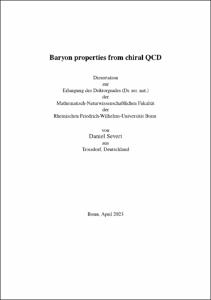Baryon properties from chiral QCD

Baryon properties from chiral QCD

| dc.contributor.advisor | Meißner, Ulf-G. | |
| dc.contributor.author | Severt, Daniel | |
| dc.date.accessioned | 2023-06-05T11:15:30Z | |
| dc.date.available | 2023-06-05T11:15:30Z | |
| dc.date.issued | 05.06.2023 | |
| dc.identifier.uri | https://hdl.handle.net/20.500.11811/10872 | |
| dc.description.abstract | This thesis contains a collection of studies on the properties of baryons within the context of effective field theory, especially Chiral Perturbation Theory. The thesis focuses primarily on the Roper resonance, an excited state of the nucleon with some interesting and puzzling features. With a pole mass of approximately 1.4 GeV, the Roper mass lies below its quark model prediction. Additionally, the Roper can decay into a nucleon and a pion, as well as into a nucleon and two pions, where both branching ratios are of the same magnitude, causing an almost equal probability of two- and three-particle final states. Investigating the Roper resonance and its properties is key for understanding the excited hadron spectrum of Quantum Chromodynamics. The second part of this thesis studies electric dipole moments (EDMs) of heavy baryons containing a single bottom quark. EDMs are an important observable in precision measurements, since they violate the discrete symmetries time-reversal (T) and parity (P) at the same time. The inclusion of P- and T-violating sources is done within the framework of Standard Model effective field theory (SMEFT). Dimension-six operators from SMEFT are considered and their induced effect on the EDMs of heavy bottom baryons is calculated. | en |
| dc.language.iso | eng | |
| dc.rights | Namensnennung 4.0 International | |
| dc.rights.uri | http://creativecommons.org/licenses/by/4.0/ | |
| dc.subject | Theoretical Physics | |
| dc.subject | Quantum Chromodynamics | |
| dc.subject | Physics of Baryons | |
| dc.subject | Effective Field Theories | |
| dc.subject | QCD Phenomenology | |
| dc.subject.ddc | 530 Physik | |
| dc.title | Baryon properties from chiral QCD | |
| dc.type | Dissertation oder Habilitation | |
| dc.publisher.name | Universitäts- und Landesbibliothek Bonn | |
| dc.publisher.location | Bonn | |
| dc.rights.accessRights | openAccess | |
| dc.identifier.urn | https://nbn-resolving.org/urn:nbn:de:hbz:5-71006 | |
| dc.relation.arxiv | 2003.05745 | |
| dc.relation.arxiv | 2111.13000 | |
| dc.relation.arxiv | 2212.02171 | |
| ulbbn.pubtype | Erstveröffentlichung | |
| ulbbnediss.affiliation.name | Rheinische Friedrich-Wilhelms-Universität Bonn | |
| ulbbnediss.affiliation.location | Bonn | |
| ulbbnediss.thesis.level | Dissertation | |
| ulbbnediss.dissID | 7100 | |
| ulbbnediss.date.accepted | 26.05.2023 | |
| ulbbnediss.institute | Mathematisch-Naturwissenschaftliche Fakultät : Fachgruppe Physik/Astronomie / Helmholtz-Institut für Strahlen- und Kernphysik (HISKP) | |
| ulbbnediss.fakultaet | Mathematisch-Naturwissenschaftliche Fakultät | |
| dc.contributor.coReferee | Rusetsky, Akaki | |
| ulbbnediss.contributor.gnd | 1343691621 |
Dateien zu dieser Ressource
Das Dokument erscheint in:
-
E-Dissertationen (4384)




